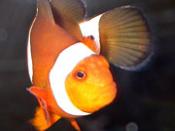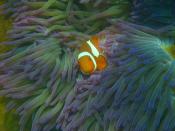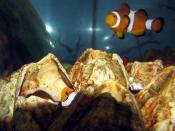There are vast ranges of beautiful marine and salt water organisms. The array of colors, behaviors, adaptations, and symbiosis are unique to each species. The Amphiprion percula, known as the True Clown Anemonefish, is distinctive for its symbiotic relationship with anemones and as a protoandrous sequential hermaphrodite. The percula clownfish is merely one of 28 known species of anemonefish that has a symbiotic relationship with 10 species of anemones (Elliott, 1997). The clown anemonefish (Amphiprion percula) is a familiar study species in the marine biology field due to its distinguishing characteristics. It is perhaps the most common and well-known of the genus Amphiprion. However, it is readily mistaken for Amphiprion oscellaris, the False Percula Clown Anemonefish, in which the only difference lies in the number of dorsal spines. The true Percula clown may possess nine to ten dorsal spines, while the False Percula Clown will have eleven. As a member of the kingdom Animalia within the phylum Chordata, the percula clownfish is in the family Pomacentridae within the Actinopterygiian class.
As a relative of the damselfish, the percula clownfish is easily identified, as it was popularized by the Disney film, ÃÂFinding NemoÃÂ. A. percula can grow up to 13 cm in length and is often distinguished by three white vertical bars on a bright orange body that are bordered by black lines; the anterior white bar behind the eye, the middle projecting bar bisects the fish, and the posterior bar occurs near the caudal fin (Lee, 2003). The marine fish possesses an omnivorous diet; it feeds on zooplankton such as copepods and larval tunicates, algae from neighboring coral reefs, leftover food from its host anemones, as well as small crustaceans.
A. percula is found within the tropical waters of the Pacific Ocean, Indian Ocean, the Red Sea, and the...


